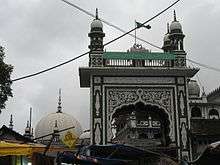Makhdoom Ali Mahimi

Makhdoom Ali Mahimi ( 1372 to 1431 A.D ) was a saint and scholar of international repute. He lived during the time of the Tuglaq dynasty and that of Sultan Ahmed Shah of Gujarat, and was married to Sultan sister. He is widely acknowledged for his scholarly treatises, liberal views and humanist ideals. Mahimi was born into a family of Arab travelers from Iraq who had settled down on the island of Mahim, one of the seven islands that later formed the city of Bombay (now Mumbai).[1]
Not much is known of his early childhood. He later became the disciple of Mohiuddin Ibne Arabi, a Spanish Muslim saint. Mahimi's reputation grew after the Sultan of Gujarat, Ahmed Shah of the Muzaffarid dynasty, chose him to be the town's Qazi (the Head Muslim Judge/cleric of a town).
Mahimi was the first Indian scholar to write an exegesis on the Qur'an, which gained critical acclimation from numerous Islamic scholars including Shah Waliullah Dehlavi. Authoring a total of nineteen books, he was given the moniker Qutub-e -Kokan (Kokan's Pole Star). He was the first commentator of the Holy Quran in India. His commentary is known throughout the World and is called "Tafsirur Rahman." It is Unique among all the commentary of QURAN known to Scholars. Which is available in Al Azhar University, Cairo and Ummul-Qura University, Makkah.
Mahimi is revered by both the Muslims and Hindus, all Muslim sects hold him in high esteem. After his death in 1431, he was buried in Mahim. The site later became a Dargah (shrine) for devotees.[2]
Urs festival
During the annual ten-day Urs festival celebrated on the 13th day of Shawwal as per the Muslim calendar, millions of devotees visit his dargah.
The highlight of this is a procession of around eight thousand begins at the Mahim Police Station, believed to be the site of his residence. Two police officers from each of the eighty four city police stations represent the police whose association with the saint dates back to the saint's era. A representative of the Mumbai police who is the first to offer the "chaddar" (shawl) at the tomb on the first day of the festival. Legend has it that it was a police constable who gave water to the dying saint from his cap. Another story points to some miraculous assistance police officers once received from an old man, whom they believed was the saint, in fighting smugglers.[3]
A room adjacent to the office of the senior inspector of police station contains a steel cupboard that houses the saint's preserved belongings such as his chair, a pair of sandals and his hand-written Qur'an which is considered to be a calligraphic work of art. The room is opened once every year to the public. In 1920 the cupboard was purchased by a senior British police inspector, Raymond Esquire as a tribute to the saint he revered.
On 2005-05-21, the government of Maharashtra named the JJ Flyover after the saint as a tribute to the saint. The 2.1 kilometre flyover is the longest viaduct in the country.
References
- A saint revered by both Hindus and Muslims, Mohammed Wajihuddin/TNN, pg 4, Sunday Times of India, Bombay, dated 2005-05-22
- On Urs, Mumbai police keep tryst with Sufi saint, S Ahmed Ali, The Indian Express, Sunday, 2002-12-22
- Sayed Imamuddin Gulshan Aabadi, Barakat-ul-Awliya, Bombay.
- Ghulam Azad Bilgrami, Rausat'ul-Awliya, Aurangabad, 1892-93.
- Bombay Gazetteer, Volume III, Bombay, 1910.
- S.M. Edwardes, Rise of Bombay, Bombay 1909.
- Maulana A. R. Parvaz Islahi, Makhdum Ali Mahimi, Naqsh-e-Kokan Publication Trust, Bombay,1976.
- Nawab Siddiq Hasan Khan, Abjad-ul-Uloon, Bhopal,1295 AH.
- Muhammed Yusuf Khatkhatey, Kashaful Maktoon
- Fi-Halat-e-Haji Ali Makhdoom, Maktaba-e-Shihabi, Bombay,1903.
- Towns and Islands of Bombay, Statistical account (Administration), Volume III, Bombay,1894.
- Prof. Abdus Sattar Dalvi, Dargahs Abodes of the Saints.
- ↑ Sadia Dehlvi (5 September 2012). Sufism: Heart of Islam. HarperCollins Publishers. pp. 211–. ISBN 978-93-5029-448-2.
- ↑ George Michell (1 May 2013). Southern India: A Guide to Monuments Sites & Museums. Roli Books Private Limited. pp. 54–. ISBN 978-81-7436-903-1.
- ↑ Mumtaz Currim; George Michell (2004). Dargahs, Abodes of the Saints. Marg Publications. ISBN 978-81-85026-65-7.